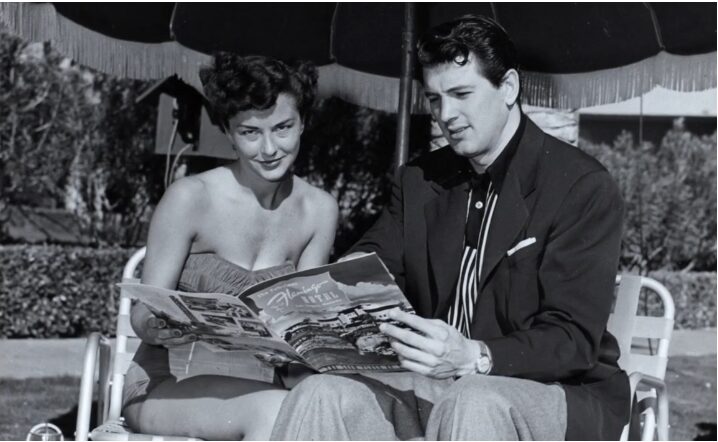Susan Cabot’s introduction
Born in Boston, Massachusetts on July 9, 1927, as Harriet Shapiro, Susan Cabot was a talented American actress most recognized for her roles in television and movies in the 1950s and early 1960s. Cabot had a bright career, but her life was tainted by emotional issues and ended tragically, leaving a deep impression on those who followed her journey. In-depth information about Susan Cabot’s early years, ascent to popularity, important works, personal life, and circumstances surrounding her tragic death are included in this page about her life and career.
Early Years and the Start of a Career
Susan Cabot experienced a difficult and turbulent childhood. She was raised mostly in foster homes and orphanages following her parents’ abandonment. Her resilient nature was probably fashioned by these early experiences, which also had an impact on her later problems. Eventually, Cabot relocated to New York City, where she attended Manhattan’s High School of Music & Art to further her education. She started her acting career in Off-Broadway performances thanks to her talent and perseverance, which brought her to the theater. She changed her identity in the entertainment industry and distanced herself from her turbulent history at this time by taking on the stage name Susan Cabot.
Ascent to Notoriety in Hollywood
Sam Katzman, a film producer, noticed Susan Cabot and offered her roles in a number of low-budget Westerns and adventure movies. This was her big break. Positive acclaim for her performances led to her signing a contract with Universal Pictures shortly after. Cabot made multiple cinematic appearances in the 1950s, starring with Audie Murphy in “The Duel at Silver Creek” (1952) and “The Battle at Apache Pass” (1952). But her career was really defined by her collaborations with director Roger Corman. Cabot portrayed the title character in “The Wasp Woman” (1959) and “Sorority Girl” (1957), two of Corman’s beloved classics. These parts demonstrated
her capacity to give characters—often found in B-movies and low-budget productions—depth and nuance, winning her a devoted following and a spot in cult cinema history.
Notable Pieces and Their Influence
Although not large, Susan Cabot’s filmography features a range of parts that demonstrate her ability as an actress. Apart from her partnerships with Roger Corman, she acted in movies such as “Machine-Gun Kelly” (1958) and “Carnival Rock” (1957), costarring with Charles Bronson. Her ability to elevate the material and represent strong, multidimensional women in these films was a credit to her talent. Among Cabot’s most notable performances is “The Wasp Woman,” which successfully combines science fiction and horror elements to cement its place in the annals of cult classics. Her contributions to genre film have made a lasting impression and impacted upcoming actors and directors.
Individual Life and Difficulties
Susan Cabot had a difficult personal life despite her success in her career. She was married twice; she filed for divorce from both her first marriage, to artist Martin Sacker, and her second marriage, to actor Michael Roman. Throughout her life, Cabot battled mental health conditions, including as acute depression and what was eventually identified as paranoid schizophrenia.
Her turbulent relationships and the demands of sustaining a Hollywood career only made these issues worse. Timothy Scott Roman, the son Cabot gave birth to in 1964, is said to have been the son of King Hussein of Jordan. Her life became much more complicated as a single mother raising Timothy since she had to deal with the duties of parenting on a personal level as well as social criticism.
The Sad Conclusion
Susan Cabot’s life ends with a devastating and unpleasant chapter. Cabot was discovered deceased in her Encino, California, home on December 10, 1986. Her son Timothy had killed her by beating her with a weightlifting bar; Timothy later stated that he had acted in self-defense because he thought his mother was possessed by a demon.
The inquiry that followed found a dysfunctional household with untreated mental illness. In the end, Timothy—who had psychological problems of his own and was dwarfed—was found guilty of involuntary manslaughter and given a probationary term. With her passing, Cabot’s serious mental health issues came to light, as did the inadequate care she and her son received.
Heritage and Cultural Influence
The difficulties that many women in Hollywood encountered are still poignantly brought to light by Susan Cabot’s life and career, especially those who battled social constraints and psychological problems. The horror and science fiction genres have benefited greatly from her collaboration with Roger Corman, and lovers of classic and cult cinema continue to laud her performances. Cabot’s terrible demise also emphasizes the significance of raising public awareness of mental health issues and the demand for improved support networks for people with mental illness and their families. Documentaries and retrospectives have revisited her narrative, making sure that her legacy lives on even after her tragic passing.
In summary
In summary, Susan Cabot’s life and career were characterized by both incredible triumphs and significant challenges. Cabot’s path was one of tenacity and willpower, from her early years spent in foster homes to her ascent to fame as a cult movie star. She endured personal hardships, including as mental health problems and a tragic death, yet her filmography still has an impact on viewers and serves as an inspiration to upcoming artists. The legacy of Susan Cabot serves as both a sad reminder of the value of treating mental health concerns with compassion and assistance, as well as a monument to her skill and the long-lasting influence of her contributions to film.




